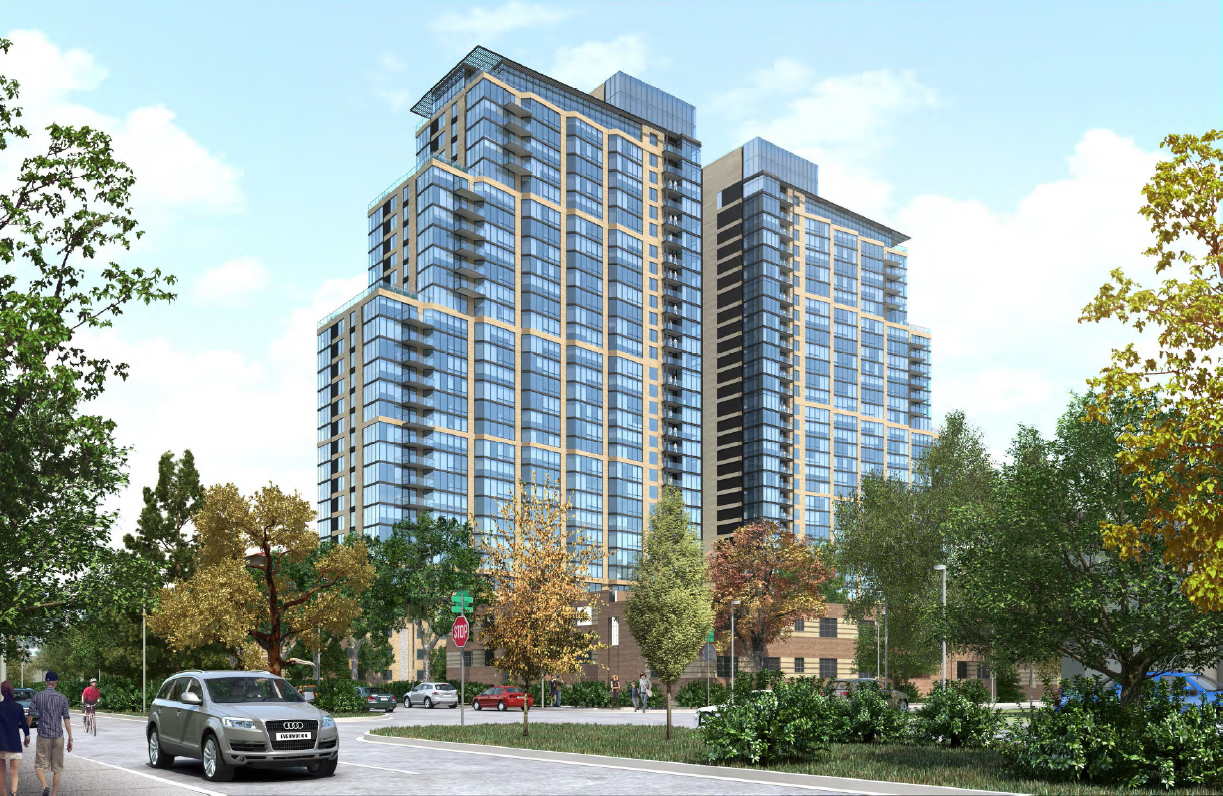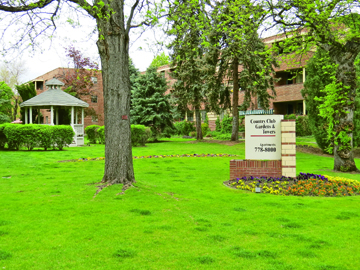Construction Of Towers Into Historic Six-Acre Site Seen By Activists As Giving Area And Denver Another Black Eye
by Glen Richardson
Country Club Gardens — the historic 1940s five-building three-story apartment complex located in a six-acre landscaped garden environment adjacent to the Downing Street Parkway — is about to get hit with a pair of huge apartment houses as densification of the Cherry Creek and Country Club areas continues on unabated. The Broe Group is demolishing two existing garden apartments and replacing them with two overwhelming 30-story towers near the intersection of Downing St. and Ellsworth Ave.
The twin skyscrapers will be the tallest buildings outside of downtown Denver and will be equal in height to the One Tower Center on 17th Street, the 15th tallest building in Denver. By comparison, Plaza Tower One — one of the tallest towers in the Denver Tech Center — is only a 22-story building. The two towers will contain a total of 533 apart ment units and several floors of structured parking. The two buildings will be mirror images of one another and top out at 322 feet in height.
ment units and several floors of structured parking. The two buildings will be mirror images of one another and top out at 322 feet in height.
The two towers, along with the existing 22 story building at 1001 East Bayaud also constructed by Broe, will block the view of the mountains for much of the Cherry Creek area.
The latest plan is in response to a hostile historic designation effort undertaken in 2007. In response to those hearings Broe agreed to retain the three northern buildings at the Gardens in exchange for the right to build out the balance of the site. Area residents however are not pleased or content with the recent Landmark Planning Commission (LPC) decision to approve the two massive residential towers. They tell the Chronicle that the development-oriented Broe Group has been jabbing away at their neighborhood icon for 20 years and the proposed massive two-tower complex represents the k nockout punch.
nockout punch.
Residents Up In Arms
How will the twin skyscrapers impact the unique character of this celebrated neighborhood? “It will be devastating to the historic significance, charm and personality of Country Club Gardens,” said Karen Mansfield. “No one likes to have dark circles under their eyes but we’re like the kid that got hit with a shiner and we are fully expecting to have two black eyes soon.” The tower design, they say, tries to put the historic area on a pedestal with a snooty, rock star look. “We’ve been hit with a catchy hook that’s simply not a good look,” said Mansfield.
Kristian Jeichler noted to the Chronicle, “This is going to drastically change the Denver skyline and life in the Cherry Creek area.” The concern is that the two buildings will indelibly alter many Cherry Creek neighborhoods for better or for worse, depending on the perspective. Residents make the case that the towers take the trajectory of the historic area in a direction that falls short. “They will forever change the Valley skyline while damaging the unique layout of the buildings, internal courtyards and connecting open space within the Gardens,” said Jonathan Pierson.
Along with concerns about the mass and scale of the towers, the Landmark Planning Commission has also expressed unease about the project’s impact on the historic courtyards and landscaping. “Preservation and compatible development of the landscape and courtyard are critical to retaining the character of Country Club Gardens,” according to the LPC report. The commission is waiting on a pending arborist report. The LPC is also providing a design review over the demolition and construction activity directly related to the project outside of the boundaries of the Country Club Gardens Historic District. This includes improvements off of Bayaud St. adjacent to the historic landmark Norman site.
Broe’s Reputation
Over the years, Developer Pat Broe has garnered a reputation as a ruthless tough negotiator who is personally despised by many people but admired for his ability to make money. Don Elliman, the former director of the Colorado Office of Economic Development and International Trade, described Broe as “a complex guy who rubs some people the wrong way…” While Tom Clark, when he was executive vice president of the Metro Denver Economic Development Corp., declared, “We counsel our clients that they will not face a more challenging negotiation than they will with the Broe company.”
When asked whether he would even do business with Broe, Elliman said he would, “But I’d have my hand on my wallet and I’d have a damn good lawyer with me.”
Excavation Impact
The fight isn’t entirely over yet, Cherry Creek Garden activists say, noting that the Landmark Planning Commission’s recommendation for approval comes with conditions. The LPC report says the mass and scale must be consistent with the development agreement and the axial views and open space preserved and reinforced. Furthermore, approval is conditional on new plantings respecting and reinforcing historic patterns. Additionally, parking is required to be screened on all sides and integrated into massing of the new structures. Few believe that any of those requirements has the possibility of derailing the project.
The Broe Group will begin work this fall to raze the parking garage and portions of two of the apartment buildings where the twin towers are to be built. Construction of the towers themselves is set to begin in early 2015, with completion in late 2016.
When questioned about the impact of construction on people living in the Cherry Creek Gardens area, a spokesman for Broe told neighborhood groups that during peak excavation a dump truck would be coming or going from the project site approximately every 10 minutes. The spokesperson added that construction staging and other activities would be performed away from the site to limit disturbance. Also workers are to be bused to the area to reduce the congestion of trucks and other vehicles within the immediate area.
What Of Historic Significance Is Being Destroyed?
Constructed in 1940, Country Club Gardens was an excellent example of the International Style exemplified by the overall horizontality of the composition. Fisher, Fisher and Hubbell Architects — a leading Denver firm at the time — designed the buildings. The firm’s principals were Arthur Addison Fisher (1878-1965), his nephew Alan Berney Fisher (1905-1978), and Edward L. Hubbell. Nicholas G. Petry (1883-1950) was responsible for construction. He came to Denver in 1921 after building the Frontier Hotel in Cheyenne. Petry built many Valley buildings including Sherman Tower, the University of Denver apartments, and several Fitzsimons Hospital and Buckley Field buildings. With both residents and passersby in mind landscape architect M. Walter Pesman planned the landscaping with meticulous detail.
